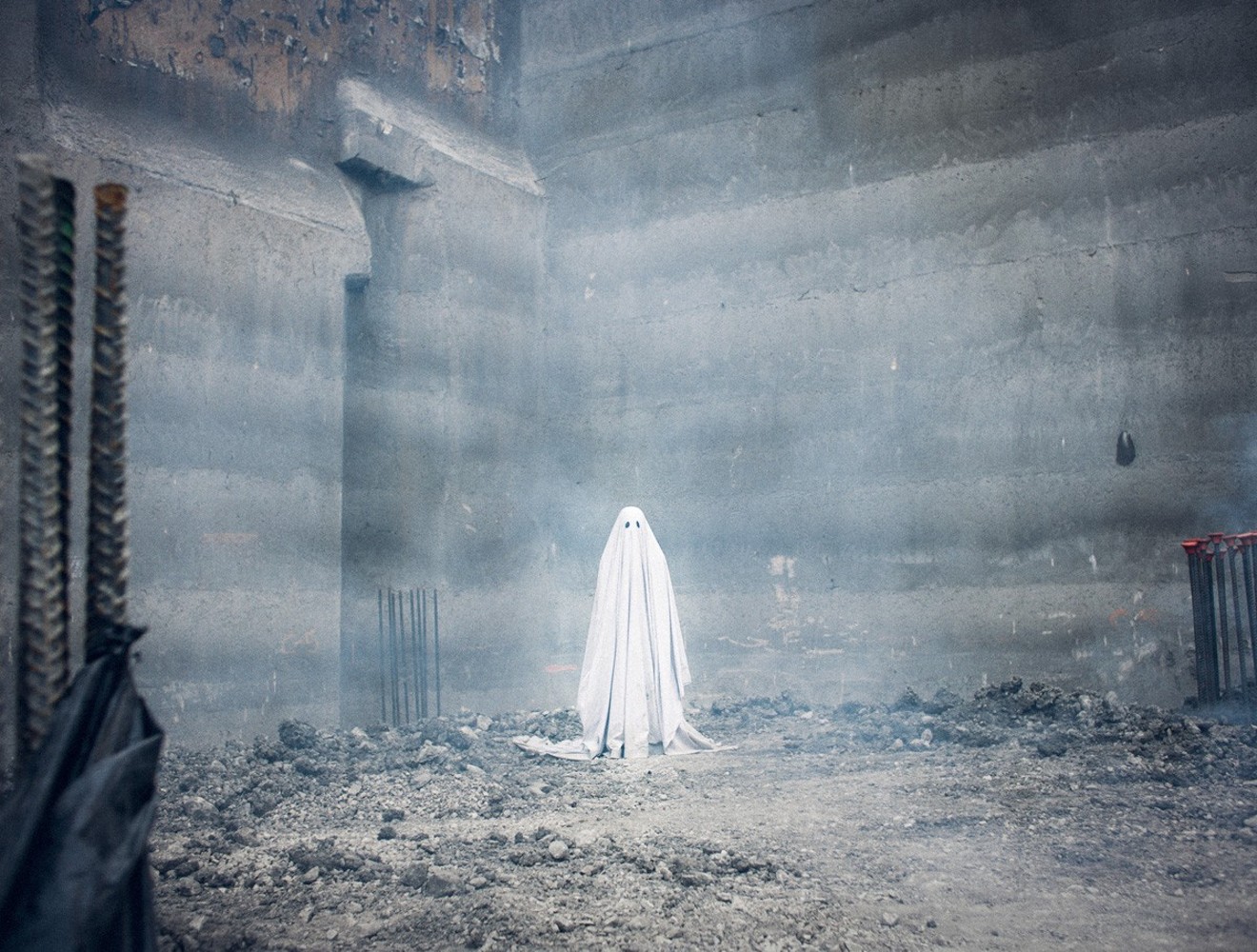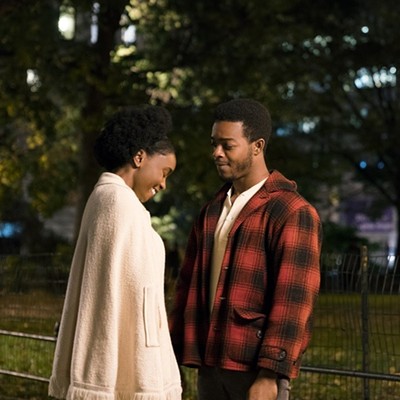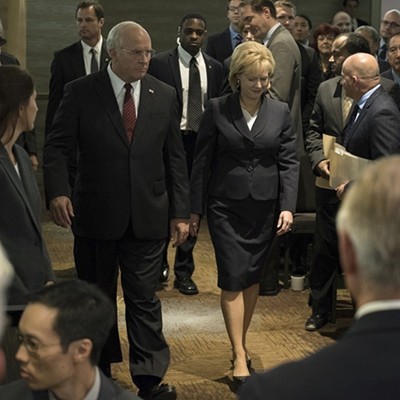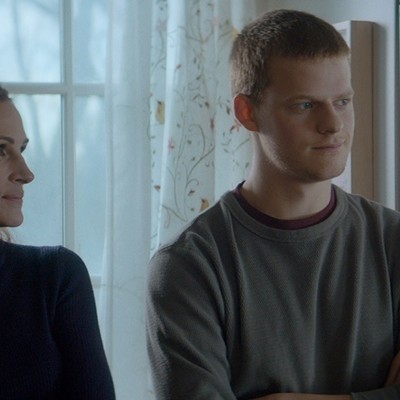“Every love story is a ghost story,” David Foster Wallace wrote, more than once. That evocative observation is probed in David Lowery’s A Ghost Story, a film that occasionally reaches a similar level of eloquence.
Lowery’s fourth feature reunites Rooney Mara and Casey Affleck, the leads of his second, the dolorous, stiff neo-western Ain’t Them Bodies Saints (2013). In A Ghost Story, they play a couple, identified only (and not until the final credits) as M and C, respectively. We first see the pair cuddled on the couch, their affectionate murmurings interrupted by a flash of ectoplasm on the wall. The spouses don’t appear frightened, though, perhaps feeling that the cocoon of their intimacy provides unbreachable protection.
The opening — and best — scenes of A Ghost Story are animated by such moments of deep conjugal closeness. After M and C are roused from their sleep by some supernatural sounds, they calmly return to bed; an unhurried take shows them wordlessly, half-drowsily navigating their immediate erotic needs.
But too soon Lowery switches from the specific to the cosmic, as the screen fills with the star-filled heavens and Daniel Hart’s score thickens with solemn strings. A Terrence Malick epigone, Lowery also relies too heavily on that elder filmmaker’s fondness for crepuscular light and time-toggling, impoverished signifiers of what Malick likes to call “life’s journey.”
An extremely unsophisticated device, however, proves strangely potent, at least initially: a white sheet in which eye holes have been cut out. This simple ghost costume adorns Affleck’s character after Mara’s identifies C’s body at the morgue. The getup is undeniably goofy but also atavistic; the elemental design made me think of the similar — if all-black and more menacing — garb worn by the phantom in Maya Deren’s avant-garde wellspring, Meshes of the Afternoon (1943).
The C specter returns to the compact Texas ranch house he shared with M, watching his beloved consume a chocolate pie, a real-time episode of emotional eating (and emesis) that’s not much more than a misguided salute to Chantal Akerman’s masterwork of mundanity, Jeanne Dielman. That this episode of sugar-snacking is the most we see Mara do after C’s death makes me pray that the talented actress will take a break from movies set in the Lone Star State — the backdrop for Saints and Malick’s Song to Song, a movie that also underutilizes the performer — and directed by quasi-macho, quasi-mystical romantics. (Maybe she should stick with the geography traversed in Carol?)
M moves out, others move in, time rewinds and advances and doubles back again, Kesha makes a cameo: The ghost bears witness to it all and even makes a friend, a fellow sheeted spook, haunting the next house over. But after this meeting of wraiths takes a cloying turn, I found it difficult to continue suspending my disbelief. Lowery, in a way, had given up the ghost.
Support Us
Houston's independent source of
local news and culture
account
- Welcome,
Insider - Login
- My Account
- My Newsletters
- Contribute
- Contact Us
- Sign out

Ain't them bodies haints.
a24
[
{
"name": "Related Stories / Support Us Combo",
"component": "11591218",
"insertPoint": "4",
"requiredCountToDisplay": "4"
},{
"name": "Air - Billboard - Inline Content",
"component": "11591214",
"insertPoint": "2/3",
"requiredCountToDisplay": "7"
},{
"name": "R1 - Beta - Mobile Only",
"component": "12287027",
"insertPoint": "8",
"requiredCountToDisplay": "8"
},{
"name": "Air - MediumRectangle - Inline Content - Mobile Display Size 2",
"component": "11591215",
"insertPoint": "12",
"requiredCountToDisplay": "12"
},{
"name": "Air - MediumRectangle - Inline Content - Mobile Display Size 2",
"component": "11591215",
"insertPoint": "4th",
"startingPoint": "16",
"requiredCountToDisplay": "12"
}
,{
"name": "RevContent - In Article",
"component": "12527128",
"insertPoint": "3/5",
"requiredCountToDisplay": "5"
}
]
KEEP THE HOUSTON PRESS FREE...
Since we started the Houston Press, it has been defined as the free, independent voice of Houston, and we'd like to keep it that way. With local media under siege, it's more important than ever for us to rally support behind funding our local journalism. You can help by participating in our "I Support" program, allowing us to keep offering readers access to our incisive coverage of local news, food and culture with no paywalls.
Melissa Anderson
Trending Film
- International Film Festival 2000
- Jonah Hill’s Mid90s Takes an Honest Plunge Into the Millennial Past
- Speed Racer Is a Fast Track to Nowhere
-
Sponsored Content From: [%sponsoredBy%]
[%title%]

Don't Miss Out
SIGN UP for the latest
news, free stuff and more!
Become a member to support the independent voice of Houston
and help keep the future of the Houston Press FREE
Use of this website constitutes acceptance of our
terms of use,
our cookies policy, and our
privacy policy
The Houston Press may earn a portion of sales from products & services purchased through links on our site from our
affiliate partners.
©2024
Houston Press, LP. All rights reserved.




